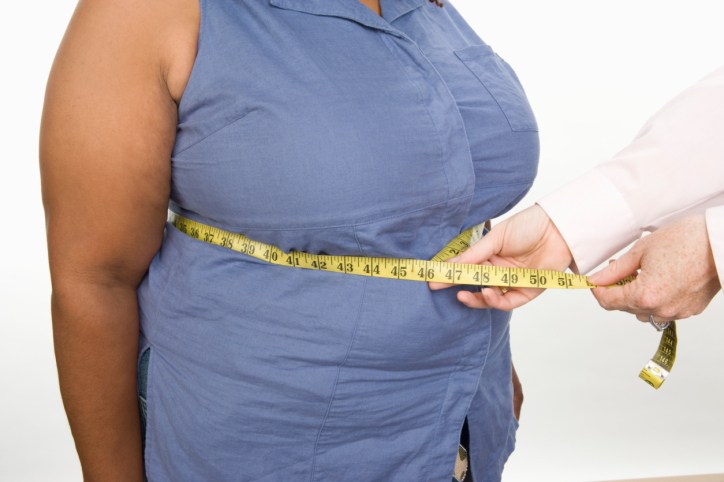Measuring Fat and Weight Loss: More Than Stepping on the Scale
BMI
Perhaps the most common indicator of a healthy weight is body mass index (BMI). Most researchers and health professionals use the BMI as a way to determine if your weight is healthy for your age and gender. To calculate BMI, use the following formula:
 For children, BMI percentiles are used to indicate the category into which a child falls:
For children, BMI percentiles are used to indicate the category into which a child falls: - Underweight (less than 5th percentile)
- Healthy weight (5th %ile to <85th %ile)
- Overweight (>85th %-ile to <95th %ile)
- Obese (>95th %ile)
Waist Circumference
One of those better options is waist circumference. This inexpensive and easy method for measuring body fatness helps to determine if your weight status affects your health. According to the National Heart Lung and Blood Institute (NHLBI), waist circumference is associated with determining your risk for diabetes, high blood pressure, and cardiovascular diseases because fat found around the waist has been linked to increased health problems. To determine your waist circumference, wrap a tape measure around your waist sitting at the top of your hip bones. (If the hip bone is difficult to find, use your belly button as a guide.)
 Make sure the tape measure is not tight around the waist, but is snug and that you are fully relaxed and breathe out. Women with a waist circumference greater than 35 inches or men with a measurement greater than 40 inches have increased health risks, such as diabetes and heart disease.
Make sure the tape measure is not tight around the waist, but is snug and that you are fully relaxed and breathe out. Women with a waist circumference greater than 35 inches or men with a measurement greater than 40 inches have increased health risks, such as diabetes and heart disease. Changes in waist circumference measurements, along with BMI, are good indicators of whether or not you have an increase in fatness, even if your BMI stayed the same. Waist circumference is more useful to those who have a BMI considered in the normal and overweight category (BMI between 18.5 - 34.9). If BMI is greater than 35 (obese), the waist circumference has not shown to be any more useful in predicting other health risks.
Waist-to-Hip Ratio
Another form of measurement is the waist-to-hip ratio, which is calculated by dividing your waist circumference by your hip circumference. Essentially, this is a calculation of the smallest section of your waist (around the belly button) and the largest section of your hip (around the buttocks).
 According to the CDC and the National Institute of Diabetes, Digestive and Kidney Diseases (NIDDK), women with a waist-to-hip ratio of less than 0.8 and men with a ratio of less than .9 are considered healthy. Anything above that could correlate health risks, such as diabetes and cancer. Yet, research is conflicting for use of the waist-to-hip ratio where some studies have shown that the ratio is not a good predictor of health problems.
According to the CDC and the National Institute of Diabetes, Digestive and Kidney Diseases (NIDDK), women with a waist-to-hip ratio of less than 0.8 and men with a ratio of less than .9 are considered healthy. Anything above that could correlate health risks, such as diabetes and cancer. Yet, research is conflicting for use of the waist-to-hip ratio where some studies have shown that the ratio is not a good predictor of health problems. If you are looking for more specifics and percentages of your body fatness, speak to your doctor about other possible measurements that require equipment such as: the dual energy x-ray absorptiometry (DEXA) which is frequently used to test bone density; bioelectrical impedance (BIA) or body fat meters. which use an electric current to measure resistance and determine body fat percentage; or skinfold thickness measurement using calipers that pinch the skin to determine the fat layer underneath the skin. In summary, to determine your weight status in a quick and inexpensive way, use a combination of your BMI, waist circumference, and waist-to-hip ratio. While each of these methods have some pros and cons, they still provide some insight into your weight and health status.
Rhea Li is a Registered Dietitian who received her Bachelor's degree in Nutrition and Master's degree in Public Health from the University of Texas. She has a special interest in working with children and has received her certification in pediatric weight management. Currently, she is working on a research study to determine the importance of nutrition in pediatric cancer patients. In the past, she has worked with pregnant women and their children. In her spare time, she enjoys being with family, exercising, traveling and of course, eating. To contact Rhea, please visit dazzlingdietitian.blogspot.com or her Twitter account, Rhea_Li.
-
Top Five Worst Exercises To Lose Weight Fast
In this article Im going to share the fi
-
How to Stock Your Fridge to Stay Healthy
Who wouldve thought? Simply by changing the way you store your f
-
5 Reasons You Still Have That Gut
(BlackDoctor.org) — No matter what angle you stand
-
Pros & Cons Of Weight Loss Testimonials
If you are a weight management enthusiast, weight loss testimonials w
-
How To Stop Gaining Happy Pounds When Youre In Love
When I had fallen in love in the past, a few months would pass a
-
Lack of Sleep: A Weighty Issue
Not getting enough sleep can do more than just make you feel sluggish
- DON'T MISS
- 5 Key Elements to Help You Choose a Great Weight Loss Program
- Learn How to Lose Weight Quickly
- Supplements That Support Weight Loss
- BodyRock Sweatography: 5 Weeks of BodyRocking
- How Appetite Suppressant Reviews Help Your Weight Loss Campaign
- Do You Understand Your Body Type?
- The Macrobiotic Diet Summarized
- How Bariatric Weight Loss Can Help You
- The Best Diet Tips
- Weight Loss Five Ways To Stay Motivated




